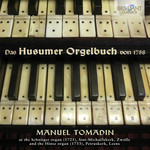
Das Husumer Orgelbuch Von 1758
 $25.00
Low Stock
add to cart
$25.00
Low Stock
add to cart
DRUCKENMULLER / ZEYHOLD / ZINCK / BRUHNS / ANONYMOUS
Das Husumer Orgelbuch Von 1758
Manuel Tomadin [Schnitger organ (1721) of the Sint‐Michaëlskerk in Zwolle / Hinsz organ (1733) of Leens, Netherlands]
[ Brilliant Classics / 2 CD ]
Release Date: Monday 8 August 2016
Should this item be out of stock at the time of your order, we would expect to be able to supply it to you within 2 - 5 business days.
The late 17th century was a golden age for the proliferation of organ music in Northern Germany. While J.S. Bach - alongside Buxtehude - may be the first name to come to mind when we consider composers of this period, more provincial towns were also surprisingly rich centres of music-making. The Husumer Orgelbuch of 1758 comprises a collection of works for organ from Husum, a coastal town situated at the tip of Germany. Organist Bendix Friedrich Zinck, whose life spanned the second half of the 18th century, chose 17 compositions for the organ to include in the collection, mostly made up of parts of old compositions. We have one example of an Adagio by Nicolaus Bruhns, also known to be active in Husum, though many years before Bendix. A more substantial body has survived of music by Druckenmüller, an almost exact contemporary of J.S. Bach. His compositions for organ are some of the first examples of the 'Italian concerto' style in northern Germany, a concerto with three movements (fast‐slow‐fast) resembling the Italian concerto grosso. Another remarkable feature of this manuscript is the fact that a vast majority of the works are original compositions rather than transcriptions - a novelty for organ music at this time, which more often involved arrangements of orchestral works, such as Bach's transcriptions of Vivaldi or Walther's of Torelli.
Italian organist Manuel Tomadin is an enthusiastic advocate of music of this period, having recently released a CD of the complete organ works of Druckenmüller alongside Daniel Erich and Georg Wilhelm Dietrich Saxer on Brilliant Classics (BC95284). As always, he has carefully selected his performing instruments, choosing a Baroque organ by Arp Schnitger - the most important organ builder of this period, who worked closely with Druckenmüller - and an organ by Albertus Hinsz in Leens, one of the closest to the tradition of Schnitger. For lovers of Baroque organ music looking to explore outside the established canon of Bach, Buxtehude and Walther, this release represents an exciting opportunity to discover some of the wealth of music‐making in Northern Germany during this period.
Performed on the Schnitger organ (1721), Sint‐Michaëlskerk, Zwolle & the Hinsz organ (1733), Petruskerk, Leens



